Трансивер Робинзона
| Уголок радиоконструктора |
The design is based on an article in the book Solid State Design for the Radio Amateur
In fact I do not need to explain everything in detail, just look at the schematic diagram and you will recognize most items. The VXO is used as the local oscillator for the direct conversion receiver and drives the final amplifier when transmitting.
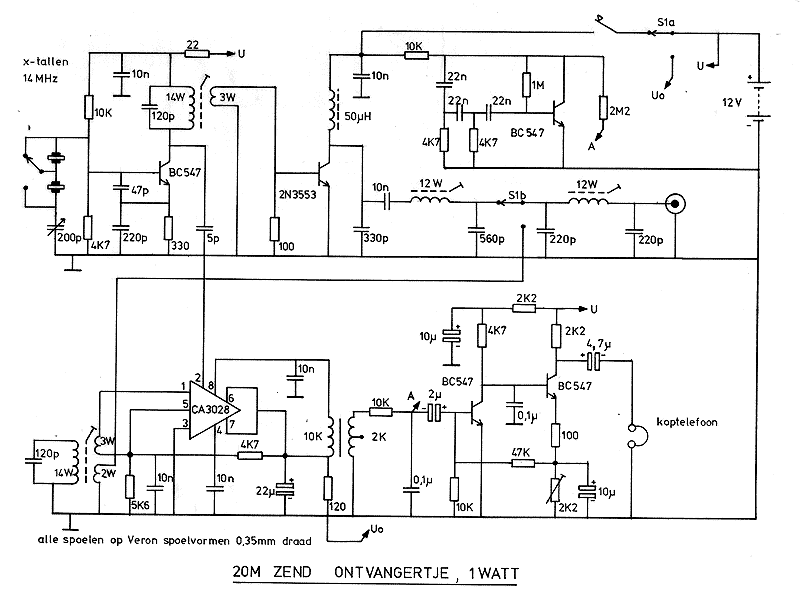
Circuit diagram, sorry for the Dutch language.
big diagram
Mixer
The mixer is an old chip, the CA3028. There are better and cheaper one's like the NE612. As the mixer is not balanced, the receiver is sensitive for AM detection of strong broadcast stations.
LF amplifier
The coupling between the two transistor LF amplifier and the mixer is via a LF transformer. And that is a problem if you use the rig nearby power lines or transformers, a loud 50 Hz hum is heard. I took a LF driver transformer of a balanced final LF amplifier from an old transistor radio.
The two transistor LF amplifier drives the headphones. Connect both earpieces in series instead of in parallel for much more audio output.
During transmission, the side tone generator is coupled via the 2M2 resistor (select the value for the side tone level you want to have) to the LF amplifier. Although there is not so much selectivity, the receiver sounds good and I always listened to it with pleasure. The 2k2 potentiometer is for the battery-empty indication. Connect the rig to the minimum supply voltage. While transmitting, adjust the potentiometer so that the side tone disappears.
VXO
The VXO frequency is varied by a simple variable mica capacitor. Via the 5 pFcapacitor, the VXO signal is fed to the mixer.
I used two crystals: 14045 and 14060 kHz, but of course you can use any frequency you like.
For the two band version, the 120 pF capacitor is removed and the tuneable coil is replaced by a FT37-43 ferrite core (same windings) and I use only one crystal per band.
Transmitter part
The VXO signal is amplified to 1 watt by a transistor 2N3553. The output is filtered in two pi sections. Why is switch S1b in the middle of the filter instead of at the end? I really do not know. In the two band version I used two 5 pole filters and switch S1b at the end of the filters. Solder a 100 pF capacitor between the collector and emitter of the 2N3553 for stability reasons.
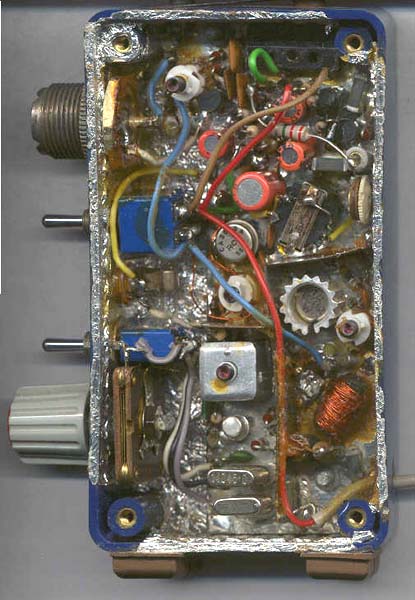
The inside view, all "Simple QRP" technology.
Notes
The CW key is a simple microswitch. When you see the photo's, you do not need a further explanation. In the 2 band version, I used an extra PNP transistor, so that the key is connected to ground.
The two earpieces of the headphone are connected in series instead of in parallel for more audio.
For the two band version, I also added a 1k potentiometer between S1b and the receiver for RF volume control.
Performance
I had a lot of fun with this rig and used it during holidays under all kinds of conditions. It always worked good!
The receiver is sensitive enough, some AM detection of strong broadcast stations is possible, the audio transformer gave problems when camping close to overhead power lines, there is no volume control, but it was real fun to use this rig. The antenna was a dipole between trees or as inverted V, the middle at 4 meters using a 5m fishing rod as a support. I also used a vertical (vertical wire mounted to the vertical fishing rod and 6 radials of 2 m length).
The rig was also used in the shack with a long wire antenna and a tuning unit. Many perfect QSO's are made, even long chats.
I also designed a new version, the 4 band HappyHoliday trx, you can find a description of it somewhere on this site.
RX current: 30 mA (quite high)
Transmit power: 0.6 W at 9 V; 1.5 W at 12 V
Harmonic suppression: Yes!
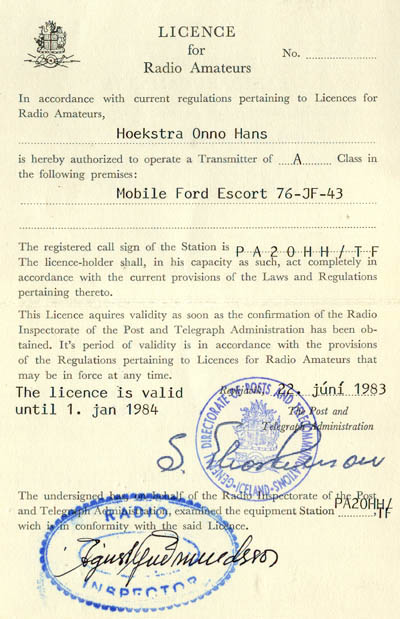
The licence for Island in 1983..
Paperwork and customs
At that time, you needed a license for each country. I did that always for the countries where I was QRV: Denmark, Norway, Sweden and Island. But they never were interested in the QRP transceivers and licences. There was another object, everyone was looking at it very suspiciously: the fishing rod used for the antenna! Fishing is illegal everywhere and if you should do that, they will kill you! Very often I had to explain that I did use that fishing rod only for the antenna and not for fishing!
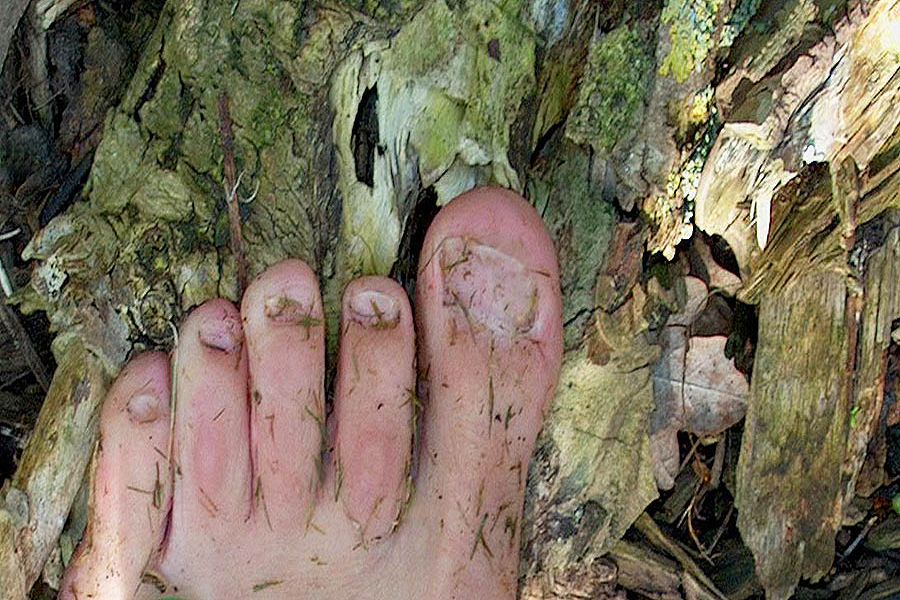
Portable with ice cold red toes in the ice cold forest!
QRP practice
And then you are standing barefoot in the pricking thistles. The antenna connected, the sked was successfull and then you want to work a couple of other stations. Calling CQ but no answer. Again with your bare feet in the prickling thistles to change the antenna direction, calling CQ and again no answer. So the antenna direction was not the problem. Normally you do give up and you are convinced that QRP does not work. But I did read some extra radio books.
Indeed, calling CQ with a QRP signal does only work around the QRP frequencies, mention also that you are QRP. But with QRP, you have to do it differently. Answer a CQ calling station instead of calling CQ yourself. That does work already much better, except when also stronger stations are answering. Then you have to loose of course. Whan also works is calling a station after the end or a QSO. Mostly they will come back for you.
The next day on bare feet in the snow on the mountain I could try out the new practice. And now I could make QSO's. Suddenly QRP was nice and I continued till my ice cold toes were half frozen in that cold snow. And the batteries that were kept warm under the thick coat were empty.
 |
 |
Cold winter weather, warm summer weather and portable at such beautiful places in nature! What do you want more!
 |
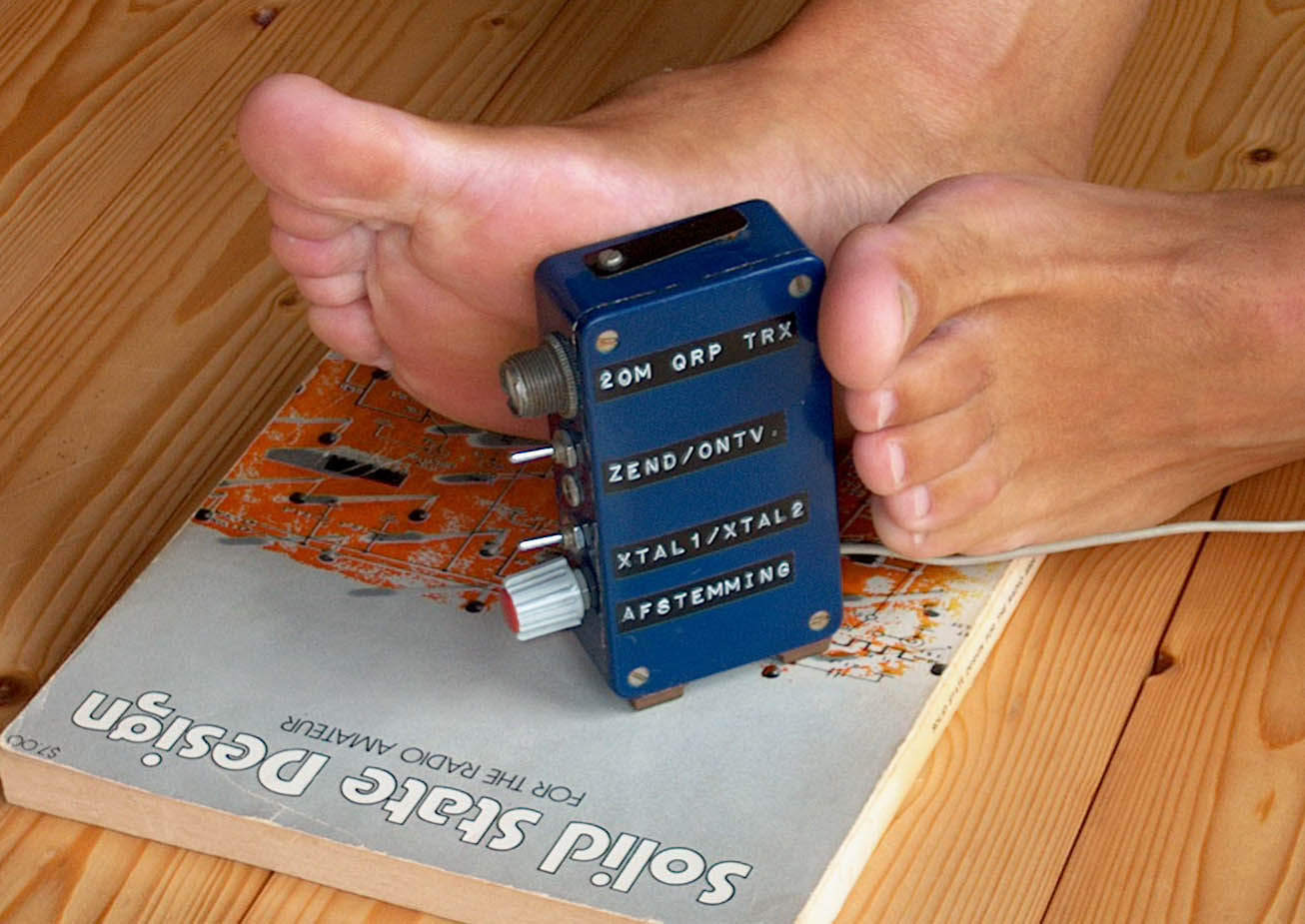 |
How much fun can you have with such a cheap and simple portable station on bare feet!
Not only to feel branches and stones, but also to feel the cold was something I really had to get used to.
Controlling the Barefooter
When you switch from transmit to receive, you have to retune the VXO a little, otherwise your receiver is zero beat with the other station. We want to keep this offset tuning as small as possible. Therefore, the other station will be heard with a low frequency audio tone. Just before the end of the transmission of the other station, we have to tune zero beat to be able to transmit on the exact frequency. If you should forget that, you will be heard most of the time when the offset is small. But there is another important reason: 400 Hz is not the most sensitive frequency of the ear but indeed the most selective frequency! Antennas
The antenna was a dipole between the trees when camping in the woods. Stones were used to throw the ropes and antenna wires over the branches. Or the same dipole was used as inverted V with the center at 4 meters using a fishing rod as a support. Also a quarter wave vertical, using the same fishing rod with 6 wires of 2meters radial wires as groundplane was used.
All antenna's worked well, I never had an SWR meter with me. The vertical with the radials was made from loudspeaker wire and a PL259 plug, sold in a local shop in Sweden. The wire length was calculated and I never verified the SWR...
http://www.qsl.net/pa2ohh/bafoot.htm